
Maoricrambus is a genus of moths of the family Crambidae. It contains only one species, Maoricrambus oncobolus, which is endemic to New Zealand. This species is classified as Nationally Endangered by the Department of Conservation.

Sabatinca calliarcha is a species of moth belonging to the family Micropterigidae. It was described by Edward Meyrick in 1912. It is endemic to New Zealand. It is found in two separate areas of New Zealand - the first in the norther parts of the North Island including Great Barrier Island and the second population can be found from the top of the South Island down to Southland. The adults of the species are on the wing from the end of September until the middle of January. The species prefers to inhabit damp forests and larvae likely feed on leafy liverwort species. Adult moths likely feed on the spores of ferns or the pollen of sedge grasses.
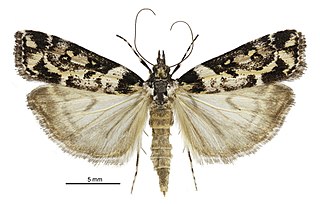
Eudonia diphtheralis is a species of moth in the family Crambidae. It is endemic to New Zealand.

Heterocrossa gonosemana is a species of moth in the family Carposinidae. It is endemic to New Zealand.
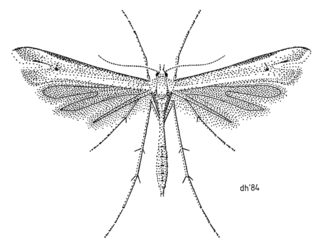
Amblyptilia lithoxesta is a moth of the family Pterophoridae. It is endemic to New Zealand. It was first described by Edward Meyrick in 1885. This species inhabits rough herbage on mountain sides. Larvae feed on Veronica buchananii. Adults are on the wing in January.

Pyroderces aellotricha, also known as the Cosmet moth, is a moth of the family Cosmopterigidae. It is found in New Zealand, in Australia and the Cook Islands.
Petasactis is a genus of moths belonging to the family Tineidae. It contains only one species, Petasactis technica, which is endemic to New Zealand. This species has not been collected since prior to 1888. It is classified as "Data Deficient" by the Department of Conservation.
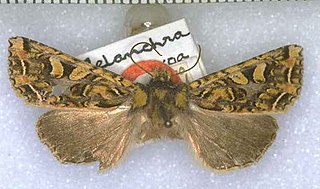
Meterana tetrachroa is a species of moth of the family Noctuidae. This species is endemic to New Zealand. It is classified as "Data Deficient" by the Department of Conservation.
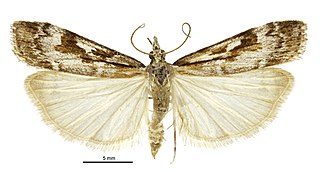
Scoparia cyameuta is a moth of the family Crambidae. It was named by Edward Meyrick in 1884. Meyrick gave a description of the species in 1885. S. cyameuta is endemic to New Zealand.

Ichneutica steropastis, or the flax notcher moth, is a species of moth in the family Noctuidae. It is endemic to New Zealand and can be found throughout the country from the Three Kings Islands to Stewart Island as well as in the Chatham Islands. The larvae of this species feed on a variety of native and introduced plants however the New Zealand flax is one of the more well known host plants for the larvae of this moth. The larvae are nocturnal, hiding away in the base of the plants and coming out to feed at night. They create a distinctive notch in the leaf when they feed. The adults of this species are on the wing from October to March. Although adult specimens of I. steropastis are relatively easy to recognise they might possibly be confused with I. inscripta, I. theobroma or with darker forms of I. arotis. However I. steropastis can be distinguished as it has a long dark basal forewing streak that these three species lack.
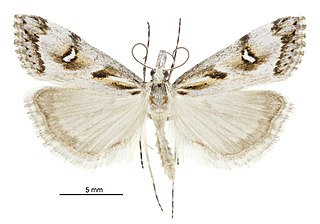
Gadira leucophthalma, the beaked moss moth, is a moth in the family Crambidae. It is endemic to New Zealand. It is found in the south eastern side of the South Island down to Banks Peninsula. G. leucophthalma inhabits the foredunes of coastal areas. The larval host is unknown but it has been hypothesised that the larvae feed on moss. The adult moths are day flying although some specimens have been trapped at night via light traps. Adults are commonly on the wing from March to April. This species has been classified as Nationally Vulnerable by the Department of Conservation.
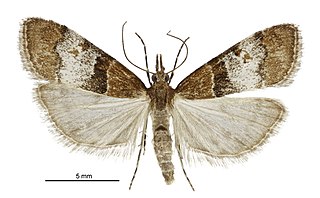
Antiscopa acompa is a moth in the family Crambidae. It was first described by Edward Meyrick in 1884. It is endemic to New Zealand and is found both the North and South Islands. The species inhabits native forest and adult moths are attracted to light.
Eudonia homala is a moth in the family Crambidae. It was described by Edward Meyrick in 1885. It is found in Australia, where it has been recorded from South Australia.

Eudonia legnota is a moth in the family Crambidae. This species was named by Edward Meyrick in 1884. It is endemic to New Zealand.

Eudonia leptalea is a moth in the family Crambidae. This species is endemic to New Zealand, including the Chatham Islands.

Eudonia psammitis is a moth in the family Crambidae. It was named by Edward Meyrick in 1884. Meyrick gives a description of the species in 1885. It is endemic to New Zealand, including the Campbell Islands.
Scoparia gomphota is a moth in the family Crambidae. It was described by Edward Meyrick in 1885. It is found in Australia, where it has been recorded from Tasmania.
Scoparia philonephes is a moth in the family Crambidae. It is found in Australia, where it has been recorded from Victoria and South Australia.

Ichneutica paracausta is a moth of the family Noctuidae. This species is endemic to New Zealand. It is found locally in the central North Island, is widespread in the South Island and can also be found in Stewart Island. I. paracausta is variable in colour, but as it has a distinctive black streak on its forewing as well as a wing pattern that is characteristic, I. paracausta is unlikely to be confused with other species. It is present on the North Island volcanic plateau as well as Little Bush Reserve in Hawkes Bay in the North Island as well as in tussock grassland, alpine and subalpine shrubland and in alpine forest. Larvae have been recorded as feeding on grasses, a pupa has been found in a cocoon under the bark of a tree and adult moths are on the wing from October to January.

Orthenches chlorocoma is a moth of the family Plutellidae first described by Edward Meyrick in 1885. It is endemic to New Zealand and has been observed in the North and South Islands.















